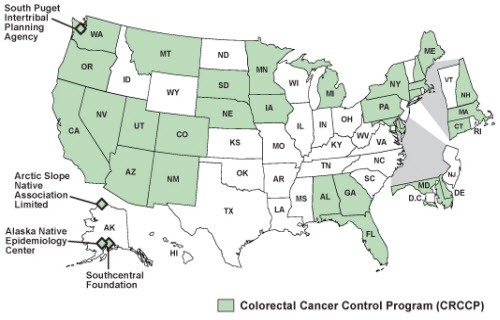Related Topics
About the ProgramColorectal Cancer Control Program (CRCCP)

CDC's Colorectal Cancer Control Program (CRCCP) has provided funding to 25 states and 4 tribes across the United States since 2009. The CRCCP's goal is to increase colorectal (colon) cancer screening rates among men and women aged 50–75 years to 80% in the funded states by 2014. An increase in screening rates will reduce illness and death caused by colorectal cancer.
The program has two components: screening promotion and screening provision.
Screening Promotion
Local CRCCP programs use evidence-based strategies recommended by the Task Force on Community Preventive Services to increase colorectal cancer screening, adapting them to their unique needs and situations. Local CRCCP programs collaborate with local comprehensive cancer control programs and other partners to share resources for efficiency.
Screening Provision
Local CRCCP programs provide colorectal cancer screening and follow-up care to low-income men and women aged 50–64 years who are underinsured or uninsured for screening, when no other payment option is available. When possible, screening services are integrated with other publicly funded health programs or clinics that serve underserved populations, such as CDC's National Breast and Cervical Early Detection Program,National Breast and Cervical Early Detection Program, CDC's WISEWOMAN Program, and the Health Resources and Services Administration's Health Centers.
Between January and December 2011, the most recent year of clinical data available, the CRCCP provided 11,504 colorectal cancer screening exams. From the program’s inception in 2009 through December 2011, the CRCCP has provided screening to 19,899 clients and diagnosed 50 colorectal cancers and 2,917 pre-cancerous adenomatous polyps.
States and Tribes in CDC’s Colorectal Cancer Control Program

States include Alabama, Arizona, California, Colorado, Connecticut, Delaware, Florida, Georgia, Iowa, Maine, Maryland, Massachusetts, Michigan, Minnesota, Montana, Nebraska, Nevada, New Hampshire, New Mexico, New York, Oregon, Pennsylvania, South Dakota, Utah, and Washington. Tribal organizations include the Alaska Native Tribal Health Consortium, the Arctic Slope Native Association, the South Puget Intertribal Planning Agency, and Southcentral Foundation.
Colorectal Cancer Screening Saves Lives
Colorectal cancerColorectal cancer—cancer of the colon or rectum—is the second leading cause of cancer-related deaths in the United States. In 2009, 51,848 people in the United States died of colorectal cancer (26,806 men and 25,042 women).1*
Colorectal cancer screeningColorectal cancer screening can find precancerous polyps (abnormal growths in the colon or rectum) so that they can be removed before turning into cancer. Screening also helps find colorectal cancer at an early stage, when treatment often leads to a cure. About nine out of every 10 people whose colorectal cancer is found early and treated are still alive five years later. If everyone aged 50 or older had regular screening testsscreening tests and all precancerous polyps were removed, the majority of deaths from colorectal cancer could be prevented.
- More: Related Topics
- Free or Low-Cost Breast and Cervical Cancer Screening
- Preventing Infections in Cancer Patients
- Health Disparities in Cancer
- Research Article Summaries
- Basic Information about Cancer Survivorship
- Caregivers for Cancer Patients and Survivors
- Cyber Cancer Registry
- Colorectal Cancer Control Program (CRCCP)
- National Breast and Cervical Cancer Early Detection Program (NBCCEDP)
- National Comprehensive Cancer Control Program (NCCCP)
- National Program of Cancer Registries (NPCR)
- Guide to Promoting Cancer Prevention in Your Community





